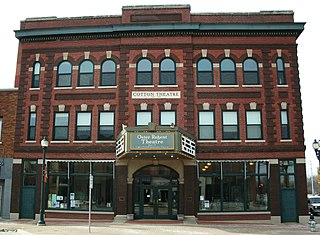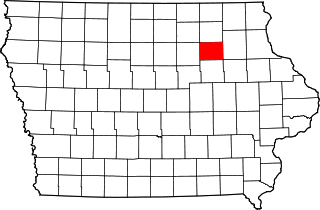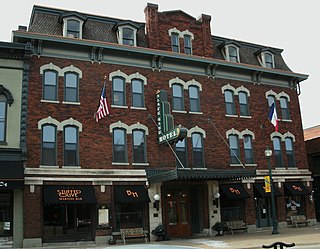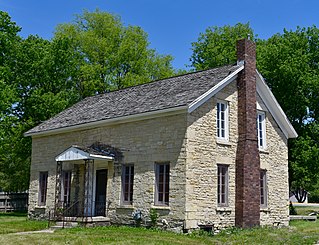
Waterloo is a city in and the county seat of Black Hawk County, Iowa, United States. As of the 2010 United States Census the population decreased by 0.5% to 68,406; the 2019 Census estimates the population at 67,328, making it the eighth-largest city in the state. The city is part of the Waterloo – Cedar Falls Metropolitan Statistical Area, and is the more populous of the two cities.

The Cotton Theatre, also known as Regent Theatre and Oster Regent Theatre, is a theater located at the corner of 1st Street and Main Street in downtown Cedar Falls, Iowa, United States. It was named for local Cedar Falls resident Frank Cotton who built the theater in 1909 and 1910.

This is a list of the National Register of Historic Places listings in Bremer County, Iowa.

The Cedar Falls Independent Order of Odd Fellows Temple, in Cedar Falls, Iowa, also known as Odd Fellows Temple or 4th and Main Building, is an Independent Order of Odd Fellows building that was built during 1901–02. It is a three-and-a-half story building on a 46 feet (14 m) by 132 feet (40 m) base.

The Black Hawk Hotel is an historic building located in downtown Cedar Falls, Iowa, United States. It was individually listed on the National Register of Historic Places in 2002. In 2017 it was included as a contributing property in the Cedar Falls Downtown Historic District.

Josselyn & Taylor was an architectural firm in Iowa.

The Cedar Falls Historical Society is located in Cedar Falls, IA. It strives to preserve the history of Cedar Falls, Black Hawk County and Iowa through its collection and five museums. It is also involved with community outreach, garden tours, guided tours, and research.

The Black Hawk County Soldiers Memorial Hall, also known as Veterans Memorial Hall, is a Classical Revival veterans hall located at 194 West Fifth Street in downtown Waterloo, Black Hawk County, Iowa. It was built from 1915 to 1916 by the Grand Army of the Republic as a memorial to soldiers who died in the American Civil War. It was listed on the National Register of Historic Places in 1988 due to its architecture and importance in local history.

The Mills Tower Historic District is a nationally recognized historic district located in Iowa Falls, Iowa, United States. It was listed on the National Register of Historic Places in 1990. At the time of its nomination the district consisted of six resources, including two contributing buildings, and four non-contributing buildings. All of the buildings are associated with the Illinois Central Railroad (IC). The Dubuque & Sioux City Railroad, an affiliate of the IC, laid the first rail track to Iowa Falls in 1866. The following year the Iowa Falls & Sioux City Railroad, another IC affiliate, continued construction of the line to the west, and it reached Sioux City by 1870. The Burlington, Cedar Rapids and Northern Railway (BCR&N) by way of its affiliate the Cedar Rapids, Iowa Falls & North Western, entered Iowa Falls in 1880. Two years later it was expanded to the north and intersected with the IC main line, which required a controlled crossing. Little is known about this first crossing and what it contained.

The Dunsmore House is a historic building located in Waterloo, Iowa, United States. Thomas Chadwick, a master stonemason originally from England, built this house from native rusticated limestone about 1866. It is one of the earliest extant houses, and the only house made of limestone block still extant in the Waterloo-Cedar Falls area. John F. Dunsmore, who worked for the Illinois Central Railroad, was the first occupant. The house features a symmetrical five bay facade, a brick chimney, and simple wooden cornice. A frame addition was built onto the back of the house in 1913. The wood and wrought iron porch is not original. The house was listed on the National Register of Historic Places in 1977.

The Waterloo Public Library is a historic building located in Waterloo, Iowa, United States. The public library was established there in 1896. It operated out of two rented rooms, one on the east side of the Cedar River and other on the west side. The Carnegie Foundation agreed to grant the community $21,000 to build this building and a similar amount for the east side branch on April 11, 1902. Waterloo architect J.G. Ralston designed both buildings in the Neoclassical style. They were both dedicated on February 23, 1906. The single-story brick structure has a projecting entrance pavilion capped with a triangular pediment that is supported by Ionic columns. Also noteworthy are the corner piers that feature bands of brick squares set into the stone. In 1977 voters in Waterloo approved a $3,650,000 bond referendum to renovate the city's 1938 post office and federal building to house the library. The post office vacated the building in 1979 when it relocated. The old library building was listed on the National Register of Historic Places in 1983. It now houses law offices.

The Waterloo Public Library-East Side Branch is a historic building located in Waterloo, Iowa, United States. The public library was established here in 1896. It operated out of two rented rooms, one on the east side of the Cedar River and other on the west side. The Carnegie Foundation offered a grant of $30,000 to build a new library, but disagreements erupted over whether to place the building on the east side or west side of the river. They then agreed to grant $40,000 for a mid-river building, or the same amount for two buildings. In the end they agreed to grant the community $24,000 to build this building and a similar amount for the west side branch. Waterloo architect John G. Ralston designed both buildings in the Neoclassical style. Both were dedicated on February 23, 1906. The single-story Bedford stone structure was built over a raised basement. It is one of the few stone buildings in Waterloo. The building has a central portico with paired Ionic columns. It is part of a larger central mass that is oriented from front to back and sits across the lower hipped roof.

The La Porte City Station, also known as the La Porte City Hall, is a historic building located in La Porte City, Iowa, United States. It was built as a depot for the Waterloo, Cedar Falls & Northern Railroad, an interurban system. The system began in 1885 as the Waterloo Street Railway Co., and grew to include routes to Cedar Falls (1897), Denver, Iowa (1901), and Waverly (1906). In 1912 it was expanded to Cedar Rapids, and this building was constructed at that time. It is a single-story, brick, Georgian Revival structure. It served as a depot until 1928, when it was replaced by a new building that was more freight focused rather than passenger focused as this depot was. This building was acquired by La Porte City at that time for use as a city hall. The community's public library was organized in 1945, and it was located here as well. The building was listed on the National Register of Historic Places in 1979. The library has subsequently been moved to a different building on Main Street.

Grace Methodist Episcopal Church, also known as Mount Moriah Missionary Baptist Church, is a historic building located in Waterloo, Iowa, United States. The congregation that built this building was organized in 1861 as First Methodist Episcopal Church. They built church buildings in 1865 at Lafayette and East Fifth Streets, and then at East Fourth and Mulberry Streets in 1877. They changed their name to Grace in 1895. They completed this building at Walnut and East Fifth Streets in 1913. The brick, Neoclassical structure designed by Turnbill & Jones features a large central dome and a large classical portico with six Ionic columns. Mount Moriah Missionary Baptist Church acquired the building from Grace United Methodist in 1996. The building was listed on the National Register of Historic Places in 2011.

The Waterloo West Commercial Historic District is a nationally recognized historic district located in Waterloo, Iowa, United States. It was listed on the National Register of Historic Places in 2014. At the time of its nomination the district consisted of 25 resources, including 22 contributing buildings, and three non-contributing buildings. The buildings are from one to three stories in height, and for the most part are clad in brick. The earliest building dates to 1882 and the latest, as of 2014, to 2000. For the must part they utilize the Victorian, Romanesque Revival, and Italianate commercial styles. Ornamentation is minimal. The buildings are all commercial structures with the exception of the former Burlington, Cedar Rapids and Northern Railway Depot, designed by the Cedar Rapids architectural firm of Josselyn & Taylor. Several of the buildings housed automobile-related businesses that clustered along West Fifth Street beginning in the 1920s and 1930s.

The Hotel President, also known as the Park Towers Apartments, is an historic building located in downtown Waterloo, Iowa, United States. The building was completed in 1929, and it opened as a "showcase hotel." In 1948, Paul "Pinkie" George and five other wrestling promoters from the Midwest founded the National Wrestling Alliance in the hotel. The manager of the hotel at the time was Lark Gable, the grandfather of Olympic gold medal winner Dan Gable. Various companies owned and operated the hotel until it was acquired in 1968 by Elders Inc., a nonprofit group of churches. They converted the building into subsidized housing. It was bought by local developers Brent Dahlstrom and Jim Sulentic in 2011 and they sold it to Huntley Witmer Development of Los Angeles. Huntley Witmer spent $12 million in 2015 renovating the building that continues to house 84 units of federally subsidized housing. It was listed on the National Register of Historic Places in 2017.

The Daniel and Margaret Wild House is an historic building located in Cedar Falls, Iowa, United States. Designed by William A. Robinson, the two-story frame Queen Anne was completed in 1895. It features a rooftop porch turret, pink granite foundation, and the use of exotic woods such as circassian walnut and Georgia curly pine. The house was built for Daniel and Margaret Wild and their family. Daniel Wild was a German immigrant who settled in Cedar Falls in 1853, the same year he married Margaret. He owned a brick company by 1868 and then expanded into lumber, coal, farming and rest estate. The house was listed on the National Register of Historic Places in 2017.

The old Cedar Falls Post Office is an historic building located in Cedar Falls, Iowa, United States. Completed in 1918, this was the city's first federal government building, and Black Hawk County became the only county in the state with two post offices that reported directly to the United States Post Office Department. It was built at the time when the design of federal building's were controlled by the Department of the Treasury. This building was designed by James A. Wetmore, who was the Acting Supervising Architect of the U.S. Office of the Supervising Architect. It was built by Des Moines contractor Frederick C. Weitz. The single-story Neoclassical brick structure features a symmetrical facade, a slightly recessed central bay, a round-arched entryway flanked by round arched windows, and Bedford stone trim.

The Waterloo East Commercial Historic District is a nationally recognized historic district located in Waterloo, Iowa, United States. It was listed on the National Register of Historic Places in 2011. At the time of its nomination the district consisted of 36 resources, including 28 contributing buildings, and eight non-contributing buildings. The city of Waterloo was established in the early 1850s. Its first settlers started developing the west side of the city before crossing the Cedar River and developing east side. The first Black Hawk County Courthouse was built on the east side in 1856 and East Waterloo Township was created two years later. As industry began to develop along the river, and the arrival of the first railroad in 1861, the commercial district on the east side began to grow. Also on the east side of town was the terminus of the streetcar-turned-interurban system. By 1900, the city became one of the primary wholesale and retail centers in northeastern Iowa. In 1911 the Black population increased significantly as workers, primarily from Mississippi, moved into town to work for the Illinois Central Railroad. The following year the saloons in town were closed and bootlegging, gambling, drugs, and prostitution started to increase in the area surrounding the central business district. All of these developed put together created the atmosphere of the downtown commercial district.

The WCF & N Center Point Depot and Substation, also known as the Center Point Depot Museum, is a historic building located in Center Point, Iowa, United States. The Mission Revival building was constructed in 1914 by the Waterloo, Cedar Falls and Northern Railroad, an interurban line that ran between the Waterloo – Cedar Falls area and Cedar Rapids. Passenger service ended here in 1956, and rail freight was discontinued in 1973. The station sat empty until it was renovated beginning in 1983. Other renovation projects were carried out 1998 to 1999 and 2013. The building was acquired by the Linn County Conservation Board in the early 1980s and turned into a museum and rest stop along the Cedar Valley Nature Trail, which follows the former rail bed. The building was listed on the National Register of Historic Places in 2018.






















